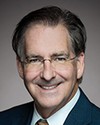Mr. Speaker, I am happy to rise on Bill C-47.
First, I want to thank members here in the chamber and those who are not for supporting Bill C-248, my private member's bill on the Ojibway national urban park, which passed almost unanimously. I thank members for that.
It is good to talk about how this place can work. I have worked, at the industry committee, on a couple of Conservative bills, one from the member of Essex, and I am glad that this Parliament is continuing, because that work will continue. However, if we do not support the budget bill, it is very clear what happens. As I hear from many members from all political sides, what they say in the chamber and sometimes in public is not the same thing as we hear in private. They are glad we are not going to an election for a lot of reasons, and they will talk about that quite openly because the consequence would be losing all private members' legislation.
I have worked with a couple of Conservative members, in particular, on their private member's bill, which are quite good. They are excellent, and a good step forward in making a difference for Canadians. One is on affordability and one is on interoperability with regard to sharing information on farming and other things. Lastly, there is one related to tax incentives, which is important for a number of reasons.
I think it is important to note, as I start to think about why I am supporting this bill, that there are some things I do not like in a bill and there are things I do like in a bill. That has been the same for me in this place for over 20 years for any government that has come forward. It does not matter which one it has been, whether it was Jean Chrétien's when I first got here or, most recently, that of the member for Papineau, the current Prime Minister. There are certain things I do like and certain things I do not like in a bill. However, overall, I am pretty proud of the NDP being able to use this opportunity to get things passed that were defeated in the previous Parliament, whether it is dental care or more housing initiatives.
They are not all of the things we wanted and asked for, and we wanted other things to go with them, but we are 25 members moving this country forward. Also, imagine going through another election during a pandemic with no results and it costing hundreds of millions of dollars. The Speaker would have to go through another election for the Speaker position, and we would have all the rigamarole to get the House back in operating form, for probably a regular scenario like we have here.
I have seen in this chamber other political parties get a lot less or not do anything. I remember that during the Harper minority years, the Liberals supported Harper over 100 times without an amendment. Over 100 times they supported the government de facto, letting it operate as a majority government without any challenges. During that time, Harper brought in the HST, a new tax on consumers, and even taxed hospital parking lots, which are no longer taxed. I could go on with a bunch of things that happened with no resistance whatsoever from the Liberals at that time. We sat next to each other in the old chamber, and I remember asking why they were not doing anything about it. They said they did not want to be bothered right now. We bother because we have to fight for things.
When I got here, there were only 14 New Democrats, and we played our role, as anybody in opposition, in trying to hold the government to account for a lot of reasons, such as making change and so forth. Then, when Jack Layton joined us, there was a real change in where we were. With where we stand today, we want to make propositions as well as be in opposition. That is what Jack instilled in many of the members here today.
With the culture we now work in on a regular basis, we look at this as an opportunity to get what Tommy Douglas wanted. Tommy Douglas wanted eye care, dental care and pharmacare as part of the full package, and that is part of what drove us as New Democrats. It was the understanding that our freedom, our sense of well-being and our health are so critically important, not only to us and our families but also to the economy and society, that they should be the number one things protected. That is one of the reasons Tommy Douglas was voted the number one Canadian, with the population supporting him as Canada's favourite Canadian.
We are now realizing a part of that dream that never came to fruition. It is important to recognize that each province does have some elements of dental care and some elements that are stronger than others. However, this is not across the whole country from coast to coast to coast.
In the area I represent, I have a lot of child poverty and a lot of single mothers. A lot of people, including my own hygienist, do not have dental coverage. These things are wrong because they affect human health, everything from one's heart to wellness to how one feels as a person. This is all preventable.
This is money that goes back in the economy. Yes, it does cost the government money and there is a cost and expenditure there, but it is not a tax cut, which is something the Conservatives and the Liberals have done in the past. In fact, Stéphane Dion was arguing with I think Michael Ignatieff at the time about tax cuts not going deep enough and fast enough.
When there are a lot of U.S. corporations and taxes on worldwide profits, some of our industries send money back to Washington. Instead of doing that, I would rather invest in dental care, as an example, because it saves jobs and lowers the cost of jobs in Canada for foreign investment and other investment.
Earlier in the debate today, we talked about the Volkswagen plant that is coming in. I have been after a national auto policy and I do not want to see one-offs. I would rather see a strategic investment, especially when it comes to batteries and the platinum age of auto, which we are in right now. In the calculations to do the deal here is the cost of labour. When we look at the productivity of Unifor and other labour organizations in the auto sector, yes, their wages and benefits are a little higher, but they also produce significantly more and better than their counterparts.
On top of that, when there are programs with subsidies going to the worker instead of the corporation, we control those subsidies and those subsidies are not going off to other countries. They are staying here and are investing in people. Those people with those subsidies are better off regarding production and making sure we can be economically viable.
There is also the social justice argument, which should be a no-brainer. How anybody in this chamber can accept dental benefits for their own children but deny others the same thing is beyond me. I do not understand how they can come to this place and check that at door every single time. We know we get a privilege benefit from the taxpayers, but we tell them they cannot have that. By the way, we still have not fixed eye care. We do not have that either. That is wrong. We should lead by example, and leading by example means providing things that would be fair and balanced.
Coming from the border town of Windsor, Ontario, in Essex County, where we have to compete against American jobs every single day, I know from talking to executives that they want health care in this country because they know it means a lower production cost for their workers in the United States, Mexico and other places. It means less turnover and less loss of skills and abilities. Especially with an unemployment rate now of 4% to 5% and having a problem attracting workers, this is key. That is what dental care adds to the equation. It will also bring better stability at the bargaining table.
The government needs to get on this and help negotiate a settlement agreement for its workers, because we are not going to see any value in keeping the public service out right now. It is not going to pay off whatsoever, and the government needs to change that.
The point is that, yes, there is a surface cost to paying for Canadians to get dental care for themselves and their families, but it is an investment back in them, our communities and our economy versus a net loss. That is one of the reasons I will support this budget. It is going to complete at least one chapter of Tommy Douglas's dream.


